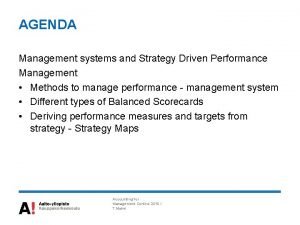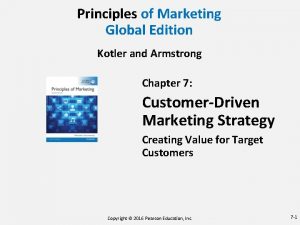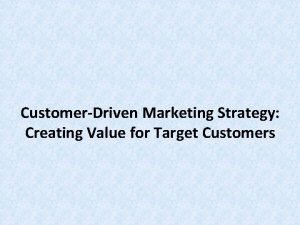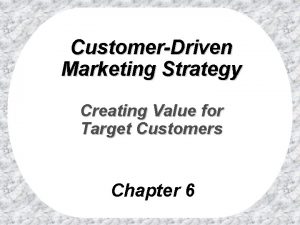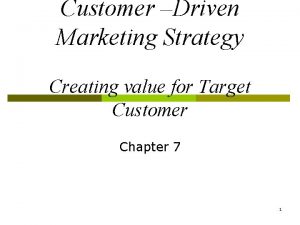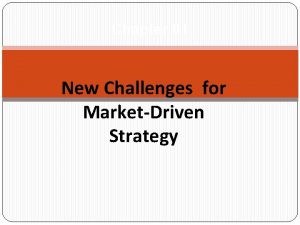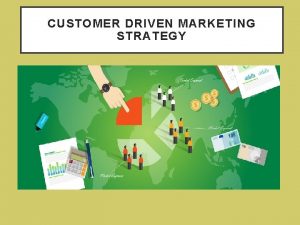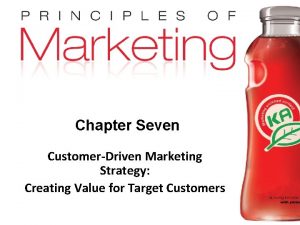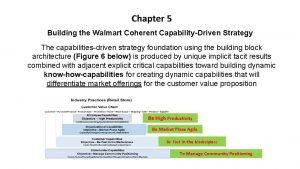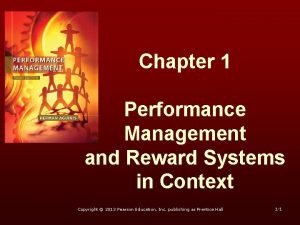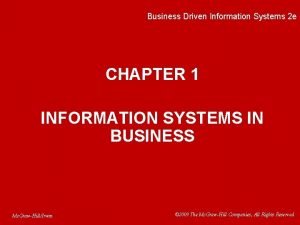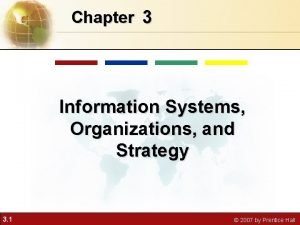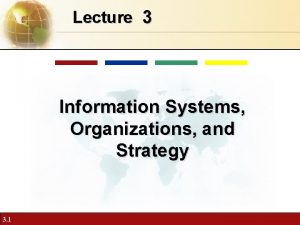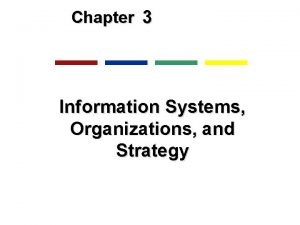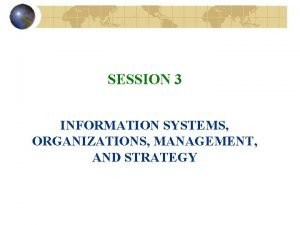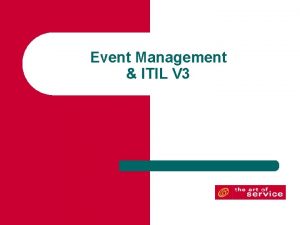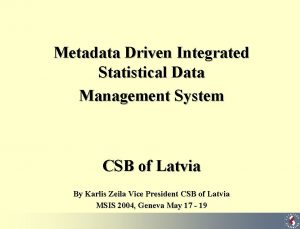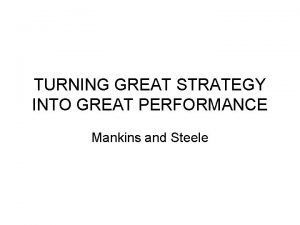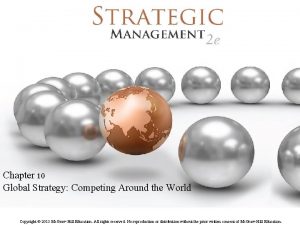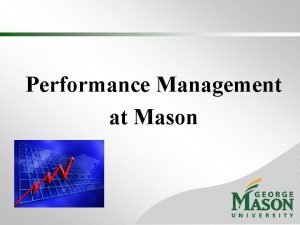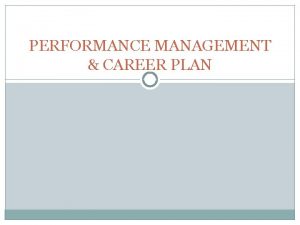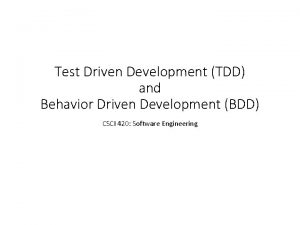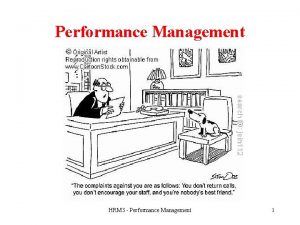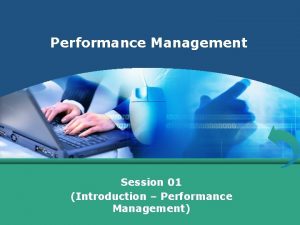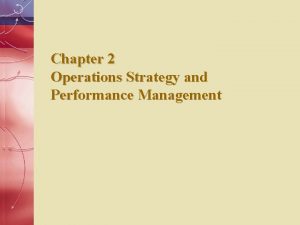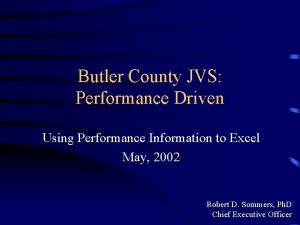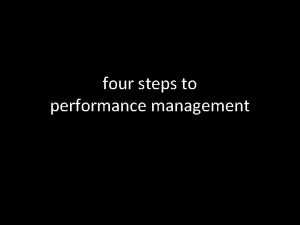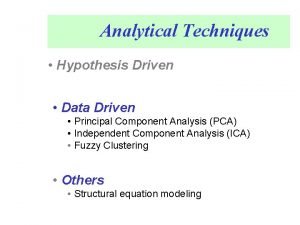AGENDA Management systems and Strategy Driven Performance Management





































- Slides: 37

AGENDA Management systems and Strategy Driven Performance Management • Methods to manage performance - management system • Different types of Balanced Scorecards • Deriving performance measures and targets from strategy - Strategy Maps Accounting for Management Control 2016 / T. Malmi

WHAT IS LEADERSHIP AND / OR MANAGEMENT? ”Leadership / management means that those things you want to get done gets done with the aid of the others” Jorma Eloranta, CEO, Metso Corporation (Talouselämä 15/2009) The core question of this course: How do we get others to do what we want them to do? Accounting for Management Control 2016 / T. Malmi

DECISION MAKING AND CONTROL To manage performance, a manager (and an organization) needs: • Information to make good decisions – – How to organize logistics? Should we introduce a new product or discontinue existing one? Where to establish the next plant? Etc. • A system of controls to ensure managers and employees at all levels do their best for the company – Accountability – Incentives – Etc. Accounting for Management Control 2016 / T. Malmi

ORGANIZATIONAL CONTROL • Ensuring that the organization is on track towards achieving its objectives – Specify objectives (plan) – Communicate objectives to organization members (communicate and implement) – Monitor performance relating to objectives (measure) – Act on discrepancies between actual and target performance (revise) Accounting for Management Control 2016 / T. Malmi

”CONTROL” AND / OR MANAGEMENT SYSTEMS • Control refers to set of procedures, tools, performance measures, and systems that organizations use to guide and motivate all employees to achieve organizational objectives • Hence, control is much more than accounting or management by objectives / management by exception! Accounting for Management Control 2016 / T. Malmi

NEED FOR MANAGEMENT CONTROL SYSTEMS • If we recruit smart people, why don’t they necessarily do what you want them to do, or do not do their best for the organization? • In other words, what are the causes of control problems? Accounting for Management Control 2016 / T. Malmi

Accounting for Management Control 2016 / T. Malmi Source: Kaplan & Norton, The Execution Premium, 2008

BASIC LEVERS OF CONTROL BELIEF SYSTEMS D E C I S I O N BOUNDARY SYSTEMS CORE VALUES RISKS TO BE AVOIDED + BUSINESSSTRATEGY CRITICAL PERFORMANCE VARIABLES STRATEGIC UNCERTAINTIES INTERACTIVE SYSTEMS Accounting for Management Control 2016 / T. Malmi DIAGNOSTIC SYSTEMS Source: Simons, 1995 S U P P O R T S Y S T E M S

PARTS OF MANAGEMENT CONTROL SYSTEM • Organizational arrangements – Organizational structure, decision rights and responsibilities – Internal governance (e. g. executive/management boards) – Task Controls / Action Controls – Ensuring compliance with standard operating procedures • • • Verification Monitoring Pre-action reviews ISO quality standards Etc. Accounting for Management Control 2016 / T. Malmi

PARTS OF MANAGEMENT CONTROL SYSTEM • Results Control – Motivating people to be creative in meeting objectives – Inform about objectives and motivate to achieve results – Budgeting, Balanced Scorecards, Quality award points – Reward systems essential part of results control • Planning – Strategic and action planning – Often linked to results controls Accounting for Management Control 2016 / T. Malmi

PARTS OF MANAGEMENT CONTROL SYSTEM • Social, personnel and cultural controls – Social controls involve selecting “right” employees – Personnel controls build on employees natural tendencies to control themselves (emphasis on job design and training in addition to selection) – Cultural controls represent set of values, social norms and beliefs that are shared by organizations members (and affect their actions) • In addition to above, various decision support systems can be regarded as part of management (control) systems, or they can be thought of as conceptually fulfilling different need Accounting for Management Control 2016 / T. Malmi

Values Long Range Planning Strategy Culture Organisation Outcomes Meeting Objectives OGSM Objectives Activities Action Planning Dashboard Budget Organisation Outcomes Short Term Financial Performance Financial Measures Scorecard C. A. Organisational Structure Accounting for Management Control 2016 / T. Malmi Governance Policies & Procedures

Values Long Range Planning Strategy Culture OGSM Organisation Outcomes Meeting Objectives Activities Action Planning Accounting for Management Control 2016 / T. Malmi Budget Organisation Outcomes Short Term Financial Performance

CONTROL PACKAGE (Malmi & Brown 2008) Cultural Controls Clans Values Planning Long range planning Action planning Symbols Cybernetic Controls Bud gets Financial Measurement Systems Non Financial Measurement Systems Hybr id Mea sure ment Syst ems Reward and Compensation Administrative Controls Governance Structure Organisation Structure - What are the altrnative ways to use these controls? Accounting for Management Control 2016 / T. Malmi Policies and Procedures

The pros and cons of various types of controls? • • • Hierachy? Matrix organizations? Exploration / exploitation? Crises? Etc. Accounting for Management Control 2016 / T. Malmi

SUMMARY • Terminology and concepts far from being clear -> make sure you understand each other within your organization • Understand the difference between systems that are used to support decision-making and systems that are used to guide peoples behavior = > you will always need both and accounting and finance can support both of these needs • Typically different functions / managers are responsible for different parts of the control system => who coordinates / make sure they form an effective and well functioning system? Accounting for Management Control 2016 / T. Malmi

AGENDA Management systems and Strategy Driven Performance Management • Methods to manage performance - management system • Different types of Balanced Scorecards • Deriving performance measures and targets from strategy - Strategy Maps Accounting for Management Control 2016 / T. Malmi

INTEGRATED PERFORMANCE MANAGEMENT FRAMEWORKS • • Balanced Scorecard Performance Pyramid Tableau du Bord Etc. • The idea of is to build a performance management system based on vision and strategy in order to translate strategy into action Accounting for Management Control 2016 / T. Malmi

FEW WORDS ABOUT STRATEGY • • What is strategy? Corporate, business and functional strategies Strategy definitions in accounting research How do we create a good business strategy / where do good business strategies come from? • Content of a good strategy statement: – Objective – Scope – Advantage • Value proposition • Internal organization Prof. Teemu Malmi 2016

MISSION Why we exist VALUES What’s important to us VISION What we wan’t to be STRATEGY Our game plan STRATEGY MAP Translate the strategy BALANCED SCORECARD Measure and focus TARGETS AND INITIATIVES What We Need to Do PERSONAL OBJECTIVES What I Need to Do STRATEGIC OUTCOMES Satisfied Shareholders Efficient Delighted Accounting for and Effective Customers Management Control 2016 / Processes T. Malmi Motivated and Prepared Workforce

BSC DEVELOPMENT PATH • First BSC: Analog Micro Devices 1988 • In 1990 development project involving 12 major US based corporations • First Harvard Business Review article in 1992 • In 1996, BSC was introduced as a strategic management system • In 2000 strategy maps to clarify strategy and to support measurement selection • Path from measurement tool to a part of management system; from measurement problems to the problem of implementing strategy, and to the clarification of strategy Accounting for Management Control 2016 / T. Malmi

Financial Perspective How do we look to shareholders? • return on investment • market share • cash flow Learning and Growth Perspective Customer Perspective Vision & Strategy To achieve our vision, how should we appear to our customers? • customer lead time • incidence of defects • reliability of lead times • price To achieve our vision, how will we sustain our ability to change and improve? • number of initiatives • employee retention • capabilities vs. needs Internal-Business. Process Perspective To satisfy our shareholders and customers, what business processes must we excel at? • cycle times Accounting for • yields Management Control 2016 / • percentage of sales from new products T. Malmi Source: Kaplan & Norton, 1996.

THREE TYPES OF SCORECARDS • Scorecards have been used for different purposes! • Key Performance Indicator (KPI) Scorecards – Management must have a multitude of measures to evaluate current performance => If measures alert, corrective actions can be taken • Strategy Scorecards – The aim is to guide organization to achieve (strategic) objectives and goals =>Is based on the logic: what you measure is what you get • Stakeholder Scorecards Accounting for Management Control 2016 / T. Malmi

WOULD THE CONTENT OF A SCORECARD BE THE SAME INDEPENDENT OF THE SELECTED APPROACH TO MEASUREMENT? • Number of measures? • Nature of measures? Accounting for Management Control 2016 / T. Malmi

AGENDA Management systems and Strategy Driven Performance Management • Methods to manage performance - management system • Different types of Balanced Scorecards • Deriving performance measures and targets from strategy - Strategy Maps Accounting for Management Control 2016 / T. Malmi

STRATEGY MAPS • Strategy Maps were originally created to derive BSC measures • There are many definitions and versions of strategy maps around • Concepts of leading and lagging indicators • It is a simplification, providing focus • Similar logic can be applied in every level in an organization Accounting for Management Control 2016 / T. Malmi

Generic Strategy Map Accounting for Management Control 2016 / T. Malmi

HOW TO COME UP WITH A STRATEGY MAP • Vision or strategic objectives provide starting point • Strategic choices, emphasis, themes, value propositions and/or projects aimed for achieving strategic objectives provide next layer • Business strategy, not all sub-strategies • Use cause-and-effect logic, top-down • Not by drawing arrows between measures ex post Accounting for Management Control 2016 / T. Malmi

CAUSE-AND-EFFECT RELATIONSHIPS “A Strategy is a set of hypothesis about the cause and effect” Kaplan & Norton, 1996 Accounting for Management Control 2016 / T. Malmi

ROCE FINANCIAL CUSTOMER LOYALTY CUSTOMER ON-TIME DELIVERY INTERNAL/ BUSINESS PROCESS LEARNING AND GROWTH PROCESS QUALITY Accounting for Management Control 2016 / T. Malmi PROCESS CYCLE TIME EMPLOYEE SKILLS

STRATEGIC THEME: SOLUTIONS IN EVOLVING SURROUNDINGS ROE = 12% => combined ratio = 106 FINANCIAL INSURANCE PREMIUM AND INCOME FROM SERVICES CUSTOMER INSURANCE, LOSS PREVENTION AND CLAIMS SERVICES CRM DEVELOPMENT OF PRODUCTS AND SERVICES EFFICIENCY AND PRODUCTIVITY IT-SYSTEMS INNOVATION AND RENEWAL PERSONNEL AND LEARNING PRODUCT AND MARKETING SKILLS TRAINING IDENTIFICATION OF CUSTOMER NEEDS PRODUCT AND SEVICES TRAINING Accounting for Management Control 2016 / RISK SEMINARS T. Malmi ORGANISATIONAL STRUCTURE, RESOURCES AND PARTNERSHIP E&M-TECHNOLOGY PERSONNEL GUIDELINES

Accounting for Management Control 2016 / T. Malmi

HOW TO COME UP WITH A STRATEGY MAP • Cause and effects need not to be verified facts – they are rather believes of management about how to compete successfully • Strategy map is always a simplification of true cause and effect relationships • Still necessary as it aids in determining focus! Accounting for Management Control 2016 / T. Malmi

MEASUREMENT • Define measures for each box in a strategy map • Strategy Scorecard should not contain everything which is important for you, it should contain issues that are crucial for you to achieve competitive advantage • Strategy Scorecard doesn’t prevent monitoring and measuring other important issues Accounting for Management Control 2016 / T. Malmi

EXCERCISE • You are concerned about your well-being in terms of physical health • Set yourself a vision and corresponding outcome measures / lagging indicators! • What shall you do to achieve your vision? In other words, what is your startegy? How could you measure that? Define some leading indicators for yourself! Accounting for Management Control 2016 / T. Malmi

STRATEGY DRIVEN TARGET SETTING • Establish targets for 3 -5 years • Establish targets that, if achieved, company and its operating processes have been changed • Part of this gets done when vision is determined • Break long-term objectives into short-term milestones connection to yearly planning and budgeting • This means target setting is done during strategy process, not during yearly planning process! Accounting for Management Control 2016 / T. Malmi

DESIGNING MANAGEMENT (CONTROL) SYSTEMS TO TRANSLATE STRATEGY INTO ACTION • Management systems consist of many different components – management by objectives only part of the picture • Requires measurement of both outcomes (lagging indicators) and means to outcomes, i. e. strategies (leading indicators) • Strategy needs to be translated to measures in all levels of an organization – linking crucial • Right set of measures is not enough – targets should be set, people should be held accountable for achieving the targets Accounting for Management Control 2016 / T. Malmi
 When you engage in unprocessed note taking, you
When you engage in unprocessed note taking, you Agenda sistemica y agenda institucional
Agenda sistemica y agenda institucional Agenda management systems
Agenda management systems Customer driven marketing strategy
Customer driven marketing strategy Market driven development adalah
Market driven development adalah Individual marketing
Individual marketing Designing a customer driven marketing strategy
Designing a customer driven marketing strategy Customer value driven marketing strategy
Customer value driven marketing strategy Market driven organization
Market driven organization Principles of marketing chapter 7
Principles of marketing chapter 7 Design a customer driven marketing strategy
Design a customer driven marketing strategy How to design a customer driven marketing strategy
How to design a customer driven marketing strategy Capability driven strategy
Capability driven strategy Customer-driven marketing
Customer-driven marketing Performance management and reward system
Performance management and reward system Business driven information systems
Business driven information systems Performance management vs performance appraisal
Performance management vs performance appraisal Performance appraisal process
Performance appraisal process Agenda open systems
Agenda open systems Corporate strategy and business strategy
Corporate strategy and business strategy Chase strategy example problem
Chase strategy example problem Information systems, organizations, and strategy
Information systems, organizations, and strategy Information systems, organizations, and strategy
Information systems, organizations, and strategy Information systems, organizations, and strategy
Information systems, organizations, and strategy Information systems organizations and strategy
Information systems organizations and strategy Chapter 3 information systems organizations and strategy
Chapter 3 information systems organizations and strategy Metadata-driven data management
Metadata-driven data management Event management in itil
Event management in itil Data-driven fleet
Data-driven fleet Market-driven management. marketing strategico e operativo
Market-driven management. marketing strategico e operativo Metadata-driven data management
Metadata-driven data management Decision support systems and intelligent systems
Decision support systems and intelligent systems Jcids process
Jcids process Turning great strategy into great performance
Turning great strategy into great performance Home replication strategy example
Home replication strategy example Transnational strategy
Transnational strategy Aligning hr strategy with business strategy
Aligning hr strategy with business strategy Global strategy
Global strategy


